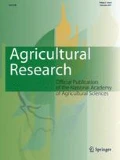Abstract
The experiment comprised of seven tomato inbred lines (two processing and five fresh market) and 21 F1 hybrids produced by crossing of them in a 7 × 7 half diallel fashion excluding the reciprocals. The study was conducted at the Haramaya University, Ethiopia during July 2015 to June 2016 to analyze the genetics of inheritance of some physical and chemical quality traits. A randomized complete block design with three replications was used to conduct the experiment. Among the studied characters, only shape index and titratable acidity fulfilled the additive–dominance hypothesis. Therefore, non-allelic gene interaction could be involved in the inheritance of the characters which did not fit the model. The parental line Roma VF contained mostly recessive genes with increasing effects for shape index, and the parental lines Marglobe and Eshete contained mostly recessive genes with the increasing effects for titratable acidity. Therefore, employing these lines in hybridization for shape index and titratable acidity improvement could be ineffective, since the rapid increased frequency of recessive alleles which is the cause of loss of vigor could be resulted in advancing generation.




Similar content being viewed by others
References
AVRDC (2007) AVRDC report 2004. AVRDC Publication No. 07-691. AVRDC-The World Vegetable Center, Shanhua, p 52
Bartlett MS (1937) Properties of sufficiency and statistical tests. Proc R Soc Lond 160A:268–282
Bauchet G, Causse M (2012) Genetic diversity in tomato (Solanum lycopersicum) and its wild relatives, genetic diversity in plants. In: Caliskan M (ed) ISBN: 978-953-51-0185-7, InTech. http://www.intechopen.com/books/genetic-diversity-in-plants/genetic-diversity-in-tomatosolanum-lycopersicum-and-its-wild-relatives. Accessed 05 June 2015
Dagade SB, Dhaduk LK, Hariprasanna K, Mehata DR, Bhatt VM, Barad AV (2015) Parent offspring relations of nutritional quality traits in 8 × 8 partial diallel cross of fresh tomatoes. Int J Appl Biol Pharm 6:45–55
Falconer DS (1967) Introduction to quantitative genetics. Longman Group Ltd., Edinburgh, pp 251–252
Foolad MR (2007) Genome mapping and molecular breeding of tomato. Int J Plant Genomics 1:643–658
Gemechis AO, Struik PC, Emana B (2012) Tomato production in Ethiopia: constraints and opportunities. In: International research on food security, natural resource management and rural development conference, 9–21 September 2012, Gottingen, Germany
Hayman BI (1954) The analysis of variance of diallel tables. Biometrics 10:235–244
Hayman BI (1954) The theory and analysis of diallel crosses. Genetics 39:789–809
Hayman BI (1958) The theory and analysis of diallel crosses: II. Genetics 43:63–85
Hayman BI (1960) The theory and analysis of diallel crosses: III. Genetics 45:155–172
Jinks JL (1954) The analysis of continuous variation in a diallel cross of Nicotiana rustica varieties. Genetics 39:767–788
Kumar R, Srivastava K, Singh NP, Vasistha NK, Singh RK, Singh MK (2013) Combining ability analysis for yield and quality traits in tomato (Solanum lycopersicum L.). J Agric Sci 5(2):213–218
Lemma D (2002) Tomatoes research experience and production prospects. Research report No. 43. Ethiopian Agricultural Research Organization, Addis Ababa, pp 33–46
Mather K, Jinks JL (1982) Biometrical genetics, 3rd edn. Champan and Hall, London, pp 252–275
Montgomery DC (2005) Design and analysis of experimentals, 6th edn. Wiley, New York, pp 97–203
Sacco A, Matteo AD, Lombardi N, Trotta N, Punzo B, Mari A, Barone A (2013) Quantitative trait loci pyramiding for fruit quality traits in tomato. Mol Breed 31:217–222
SAS (2002) Statistical analysis system software, Ver. 9.0. SAS Institute Inc., Carry
Sharma JR (2006) Statistical and biometrical techniques in plant breeding. New Age International Publishers, New Delhi, p 192
Shende VD, Tania S, Mukherjee S, Chattopadhyay A (2012) Breeding tomato (Solanum lycopersicum L.) for higher productivity and better processing qualities. Sabrao J Breed Genet 44:302–321
Singh D (1981) Estimation of second degree genetic parameters from a set of half-diallel crosses. Indian J Genet 41:246–2514
Singh RK, Chaudhary BD (1985) Biometrical methods in quantitative genetic analysis. Kalayani Publ, Ludhiana, p 123
Tamire H (1973) Characterization of Alemaya soils. Soil science paper, Alemaya University of Agriculture, Series No. 1. Haramaya, Ethiopia, p 45
Waskar DP, Kheldlar RM, Grande VK (1999) Effect of post harvest treatment on shelf life and quality of pomegranate in evaporative cooling chamber and ambient conditions. J Food Sci Technol 2:114–117
Wilcox JK, Catignani GL, Lazarus C (2003) Tomatoes and cardiovascular health. Crit Rev Food Sci Nutr 43:1–18
Acknowledgements
The authors acknowledge the Ministry of Education and Haramaya University for sponsoring this study.
Author information
Authors and Affiliations
Corresponding author
Ethics declarations
Conflict of interest
The authors declare that they have no conflict of interest.
Rights and permissions
About this article
Cite this article
Tasisa, J., Mohammed, W., Hussien, S. et al. Genetic Control of Inheritance of Fruit Quality Attributes in Tomato (Solanum lycopersicum). Agric Res 7, 120–128 (2018). https://doi.org/10.1007/s40003-018-0314-x
Received:
Accepted:
Published:
Issue Date:
DOI: https://doi.org/10.1007/s40003-018-0314-x


